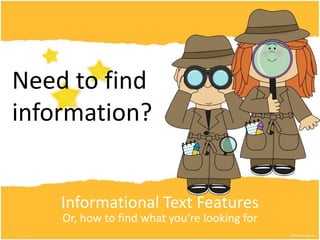Informational text features
- 1. Informational Text Features Or, how to find what youŌĆÖre looking for Need to find information?
- 2. What are Informational Text Features?
- 3. What are informational text features? Nonfiction books have special parts called text features that help us find information. Today, you will learn about the Table of Contents. We will use the Table of Contents to locate information, and reflect on how it helps us as researchers. o What is a Table of Contents? o Using the Table of Contents o Thinking about the Table of Contents
- 4. The Table of Contents
- 5. Where is the Table of Contents? A table of contents is at the beginning of a book.
- 6. What is a Table of Contents? A table of contents tells us on what page each chapter is a book begins. A table of contents tells us the main topics or chapters in a book. Table of Contents bodyŌĆ”ŌĆ”ŌĆ”ŌĆ”ŌĆ”ŌĆ”..2 foodŌĆ”ŌĆ”ŌĆ”ŌĆ”...ŌĆ”..4 habitatŌĆ”ŌĆ”ŌĆ”.ŌĆ”...5 life cycleŌĆ”ŌĆ”ŌĆ”ŌĆ”.6
- 7. Think about itŌĆ” In what ways can the Table of Contents help you find information quickly and efficiently?
- 9. What is a Table of Contents? A. A Table of Contents tells you what to expect for lunch today. B. A Table of Contents is a list of new words at the end of a book. C. A Table of Contents gives you information in pictures. D. A Table of Contents tells you what the main chapters or topics are in a book. X XX X
- 10. Working with the Table of Contents
- 11. Your job nowŌĆ” 1. Choose a book on your topic from the basket. 2. Write your name on the manila folder. Write ŌĆśTable of ContentsŌĆÖ on the sticky note. 3. Find the Table of Contents in your book and place your sticky note on that page. 4. Browse the chapter headings and complete the Table of Contents reflection sheet. 5. Cut out and glue Table of Contents reflections in your manila folder. 6. Place your folder in your book and return your book to the basket.
- 12. End of Lesson 1
- 13. More Informational Text Features
- 14. What are informational text features? Today, you will learn about the Index. We will use the Index to locate information, and reflect on how it helps us as researchers. o What is an Index? o Using the Index o Thinking about the Index
- 15. The Index
- 16. Where is the Index? An index is at the end of a nonfiction book.
- 17. What is an Index? Index antennae 2 colony 6 eye 3 food 4 head 2 jaw 3 queen 6 An index tells us what page has a specific topic. An index is in ABC order
- 18. Think about itŌĆ” How does an index help you as a researcher?
- 19. LetŌĆÖs review!
- 20. What is an index? A. An index tells you the meaning of new words you might not know in a book. B. An index is at the end of a book. C. An index tells you where to find specific information in a book. D. Both B and C X XX X
- 22. Your job nowŌĆ” 1. Retrieve your book from the basket. 2. Write ŌĆśIndexŌĆÖ on the sticky note. 3. Find the Index in your book and place your sticky note on that page. 4. Browse the listings and complete the Index reflection sheet. 5. Cut out and glue Index reflections in your manila folder. 6. Place your folder in your book and return your book to the basket.
- 23. You are on your way to becoming an Information Detective!
- 24. References Lodge, Jessica. Nonfiction text features book [powerpoint download]. Retrieved from http://www.teacherspayteachers.com/Product/Nonfiction-Text-Features-Book- PowerPoint-511585 Clip art images from http://www.mycutegraphics.com/graphics/detective-images.html
























![References
Lodge, Jessica. Nonfiction text features book [powerpoint download]. Retrieved from
http://www.teacherspayteachers.com/Product/Nonfiction-Text-Features-Book-
PowerPoint-511585
Clip art images from http://www.mycutegraphics.com/graphics/detective-images.html](https://image.slidesharecdn.com/informationaltextfeatures-140405235743-phpapp02/85/Informational-text-features-24-320.jpg)